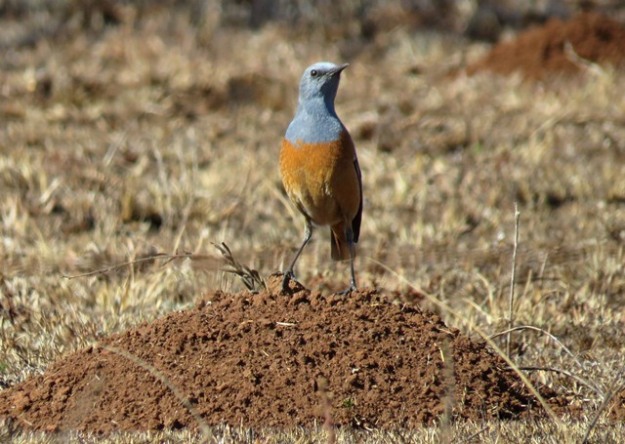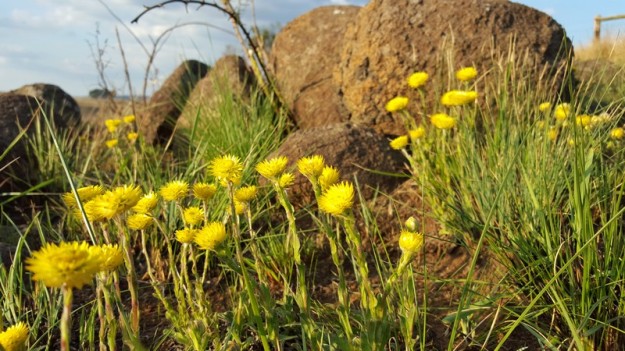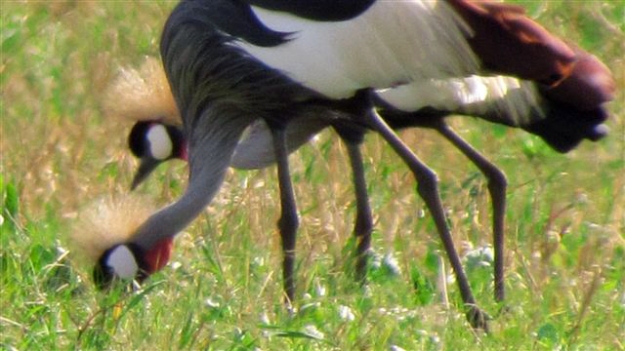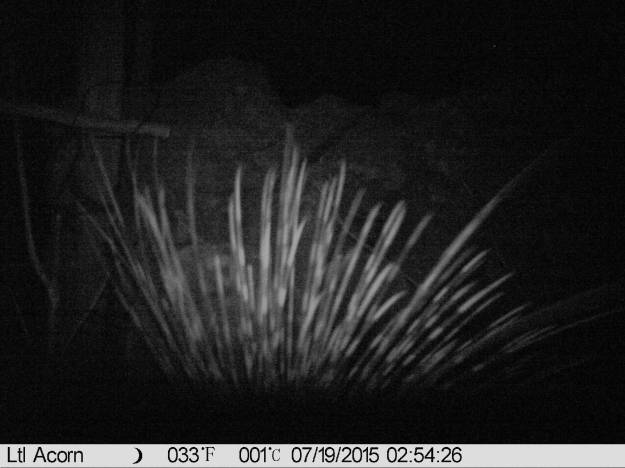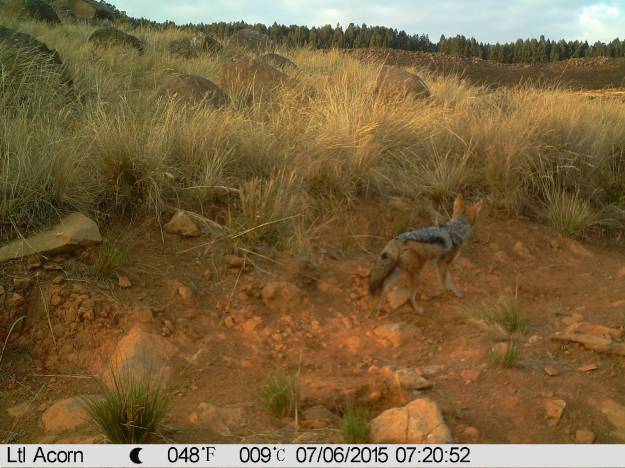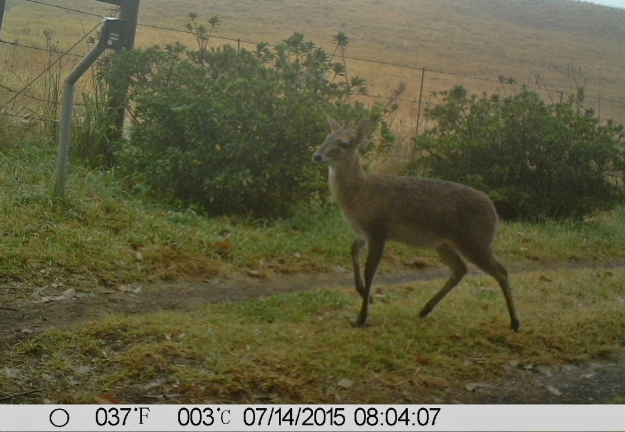Rob Mackintosh – Carlisle Farm
We had a mature bushbuck doe killed on the farm early this morning by a big cat, I have a feeling due to signs of the struggle it may have been a cape leopard. We have positively identified leopard spoor on the forest roads.

The bite marks on the neck, show the strangulation trait of a leopard suffocating prey. The carcass is still fresh and will be gone by the morning, due to the jackals.

The results of the autopsy on the carcass of the bushbuck “the bite marks and meat consumption, are very indicative of a leopard kill – but because the bites on the skull were not examined in detail, there is no proof that the bushbuck was killed by leopard” We have quite regular kills here, every 2 – 4 weeks up on the forest margins, even adult reedbuck, (Redunca arundinum) although similar in size and mass to bushbuck.

Amanda Jones of African Small Cat Research commented: This is a fully grown adult bushbuck so not sure if a caracal would take one down but you never know. I have found a reference that says caracal can take up to adult bushbuck ewes, so we can’t rule out caracal. If anyone has a trail camera nearby next time a kill is found, great idea to put it near the carcass, as the cat may come back at night.
I can’t see on the pics the teeth marks too clearly. There should be two sets of bite marks from the upper and lower canines either on the windpipe or on the spine. For Caracal average width between the teeth marks is 29mm between the upper set and 23mm between the lower set and for Leopard 45mm / 35mm.

Simon and Debbie Hayes – Hambledon
I found this snake on our lawn which the dogs had unfortunately killed. I couldn’t identify it.

(Ashley: A search on the internet turned up this webpage so I believe it is a Herald snake or Red-lipped snake: http://academic.sun.ac.za/capeherp/cederberg/snakesherald.htm)

This fallen lemon attracted a swarm of bees.

Rose and Barry Downard – Oak Tree Cottage
The hot dry weather last month attracted much bird activity around our bird bath, with sparrows, weavers, cape robins, mousebirds, white-eyes, orioles, bulbuls, drongos and lots of olive thrushes all trying to claim the bath for themselves. Due to the demand for the bird bath, we set up a couple more baths around the garden which needed topping up regularly due to water evaporation and splashing birds.
There was a great commotion one day with much hadeda squawking, and on investigation, we saw at least 16 hadedas flying overhead and circling our jacaranda tree where a gymnogene was perched. A pair of crows joined in but were more intent on chasing everyone away from their nest in a tree nearby. Eventually the gymnogene flew off with a squadron of hadedas in hot pursuit behind him!

After the heavy rain and hail recently, we discovered two dead female blackheaded orioles. They did not appear to be injured, so the extreme weather may have been too much for them. A couple of male orioles have since been heard calling loudly.

Other birds seen: Black sparrowhawk (melanistic form), herons, egrets, Fish Eagles, yellowbilled kite, guineafowls, amethyst and doublecollared sunbirds, wagtails, prinias, southern boubou, rameron pigeons, doves, fiscal shrike, swifts and swallows. A pair of Paradise Flycatchers have also been flying about the garden and are our favourite birds to watch. Heard: Redchested Cuckoo, Burchell’s Coucal. Also seen: Butterflies and moths – including Silver-striped Hawk Moth (Hippotion celerio)

Ashley Crookes – Copperleigh Farm
The Spurwing Geese were feeling very brave one morning, they were all right next to the house, checking the reflections of themselves out in the veranda glass doors. I captured a few shots before they all took off onto the dam.

Earlier in the month I was taking some salt lick out for the cows, and I was about to dump a bag of it into one of their tyres when I saw this little guy perched on the inside. He’d managed to get in alright, there was a bramble growing next to the tyre but then he couldn’t get out so I took his mugshot and then gave a helping hand. Not sure if it’s a shrew or mouse?

The porcupine is obviously out and about as well – left his calling card…

This is what the farm looked like after the massive hail storm, sadly we lost two sheep from the cold and wet.

Our driveway with all the hail. Inhlosane is in the background, can’t see it hidden behind the mist and rain clouds.

Patrick and Sandra Merrick – Albury farm
This has not been a great month for photography due to howling winds, grey and misty days. Pat saw a pair of Natal red rock rabbits in garden one night. The large grey mongoose is back swimming in the ponds and my rottie had another fight with it and came off second best. The mongoose bit through the nail and top of his paw. He is a warrior in the water and our rottie hates water.
We have seen the secretary bird on numerous occasions.

For 3 days he arrived every evening and landed on a Halleria lucida tree about 200 metres down the valley. He would jump up and down flapping his wings for about a minute and then disappear into the tree. We found this behaviour very strange and went down the next morning to see if there was a nest inside the tree but could find nothing.

A pair of gymnogene flew over the house and I got a pic of one flying off the dead tree.

The wagtails hatched out one egg in our jasmine creeper but youngster died, probably the heavy rain last week and cold. They are now building another nest in the other jasmine creeper.

The red throated wry neck is still calling for a mate standing next to the hollow gate post. I said last month that the seed eaters eating on the lawn were red shouldered widows, but now that their wings have grown, their colouring has changed, so they are actually redcollared widows.

On the day of the big hail storm our 2 blue crane landed close to the house and I got some nice pics. Now that there is a puddle in the dam they come almost every evening to wade. When I and the dogs walked past them one evening, they came towards us with wings held up halfway, crawked loudly for awhile and then proceeded to hop, skip and jump around with wings held high. They were only 10metres from us and I like to think they were greeting us and saying “here we are again waiting for the dam to fill so that we can lay our eggs once again”.

Have seen male and female duiker together and separately and still a lot of reed buck.

One morning while I was in the bedroom I spied the Southern bou bou racing across the lawn. The next second she had a snake in her beak. (It was the day of the big storm) About 30cm long and 1.5cm thick. It was in a tight coil and thrashing about, so could not see the head which she had in her beak. Silver belly and grey on top. The black flycatcher tried to get in on the action but she was having none of it. I suddenly realised that I was supposed to be photographing this but camera in kitchen and by the time I got back she had hopped into the shrubs and was busy pecking at it. As I had to go out I did not venture into the bushes to have a look but when I got back home, went and checked, but nothing left.

Heart breaking day for us. On 19th October we found a dead male oribi. He had stumpy horns and 2 lower teeth, so presumably a youngster. The ngunis were standing over his body and I thought that they had attacked him, but on investigation found that there was a large hole in the back side, and that was all that had been eaten making us wonder if the ngunis had chased the animal away. Our immediate thought was jackal but was told that they usually eat the stomach first, so we now think it may have been a caracal. We went to check the body again on Monday morning, there was nothing left! I must say we were stunned. What could have taken or eaten an entire buck including the skeleton?

Neville van Leyleveld comments: “This Oribi kill is definitely by Caracal. The feeding pattern is the tell-tale as they always only eat about a kg of the meat from the rump or from the soft inner of the rear legs. As far as the rest of the carcass that was eaten is concerned – that would have been jackal and probably bush pig.”
We still see our female oribi every few days thank goodness. We had never seen this male oribi before.

Cape Robin

Black Sunbird

Drakensberg Prinia

Lesser double collared Sunbird

Guerneys Sugarbird

Malachite Sunbird

Red faced Mousebird

Yellow eyed Canary

This Cape White eye was chased into the window. I retrieved it and put it on the windowsill in the sun to warm up and recover. It flew off after ten minutes thankfully.

Veronia oligocephala

Eriosema distinctum

Pentanisia prunelloides

Brandon Powell – Bukamanzi Cottage
The swallows are back and fixing up their nest in the cottage’s eaves.

They love to take it in turns to fly into the sitting room and preen in front of the spotty old mirror there (does anyone know why they do this?) although they’ve yet to perch on the bedposts again like they sometimes did last year, which was a real Brothers Grimm moment.

We had a magnificent fire-break evening on the D17 – the flames sometimes two storeys high and reflected wonderfully in the dam.

Thankfully the rains followed and things are greening up again.

Isn’t this the most beautiful time of year? Look at these photos taken this month only two weeks apart, each week getting greener.


I’m keeping a lookout for the resident genet (I haven’t seen him in a while) and for the Paradise Flycatcher that swooped over my head last weekend – the first one I’ve seen on this side of the Dargle.
Dieter Setz – Wakecroft
Did not see many animals on Wakecroft the past month but mushrooms are a welcome sight. Here we have the Pamaeolus Papilionaceus

Found these Coprinus plicatilis or Japanese Umbrella

This Field Mushroom is on the menu almost every day now.

Some of the invading plants are in full bloom like the American Bramble

The Wattle is also in full bloom

The Crow talks to me every morning

The Fly catcher is enjoying the abundance of flies and rests in between on my fence outside my window.

The Locusts are everywhere. This one did not make it across the road.

Helen Booysen – Kilgobbin Cottage
Lovely wildflowers spotted on my drives across the hills, including Raphionacme hirstua

Graderia scabra

Helichrysum ecklonis

More summer flowers in the Asclepias Family


These photos below were taken by one of our guests, Marzena Banasiak, at Crab Apple Cottages.
Rafiki the Samango and junior eating blossoms



Kat Herrington – Aloe Ridge Huge hailstorm in the valley

Jethro Bronner spotted these Dassies on Inhlosane during the Dargle Conservancy Spring Hike.


Nikki Brighton – Old Kilgobbin Farm
So much activity this month – porcupines eating my arum lily and sorrel roots, rabbits running around (love the early light glowing through their pink ears), samango monkeys with babies clinging to their tummies

seriously noisy tree dassies at night, two Oribi bounding across the hills, Bushbuck, plenty of Duiker and Reedbuck.

My garden is awash with White Eyes. Other busy birds include swee waxbills, drongos, mousebirds, Drakensberg Prinia, Thrushes, Choristor and Cape Robins, Southern Boubous and Spurfowl. Heard the first African Black Cuckoo of 24 October, joining the chorus of the Red Chested and Klaas’s cukoos. Stone Chats follow me on my walks.

Saw 2 Blue Cranes flying overhead a couple of times, African Harrier Hawk, Jackal Buzzards, YB Kites, Crowned Eagle and a raptor I couldn’t identify. Hear Burchells Coucal early mornings and Wood Owls at night. Watched this little wagtail splash in a puddle for ages.

Grasslands coming alive with flowers. Natal Crocus, Nemesia, Watsonia, Helichrysum, Cyrtanthus (fire lilies), Kohautia, Monopsis, Clerodendrum hirsutum, Tulbaghia

Ledebouria, Raphionacme, Acalypha, Limosella, Pentanisia, Hypoxis, Hermizygia, Lots and lots of beautiful mushrooms (feasting on the field ones, but treat others with respect)  Frogs are active now, quite deafening at night. This little Night Adder didn’t make it through the fires.
Frogs are active now, quite deafening at night. This little Night Adder didn’t make it through the fires.

Remember: The public is invited to continue to submit roadkill data and photographs. Participants should specify the location of the roadkill (preferably GPS co-ordinates), try to identify the species seen and record the date on which it was seen. Recorded roadkill sightings and photographs can be sent to roads@ewt.org.za and via the EWT’s Road Watch South Africa smartphone app which can be downloaded on http://www.prismsw.com/roadwatch/android/RoadWatchSouthAfrica.apk. The South African iTunes store also offers a facility to download the EWT’s Road Watch app for iPhone users. Additional information is available on www.ewt.org.za. Three members of the public who accurately record and submit the most roadkill sightings between 1 November 2014 and 31 January 2015 will win prizes. Prizes up for grabs include:
- Two Desert Fox 5L fuel cells, two Halogen spot light sets, and a set of off-road tyres, (Courtesy of Bike Gear);
- Two Zeus zs2100B helmets, five P1 lubes and five tyre repair kits, (Courtesy of FG Enterprises)








































